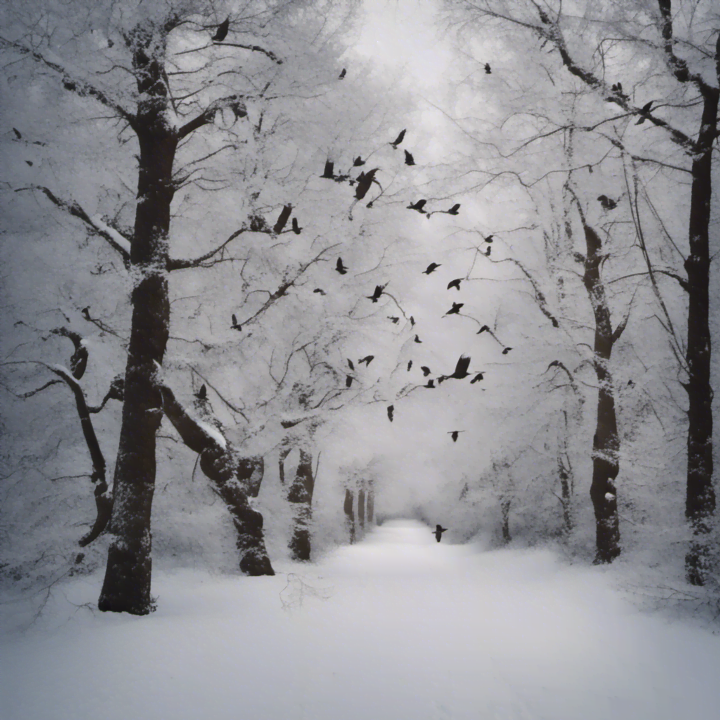Where Do Birds Migrate to in Winter

Bird migration is a marvel of nature, have you ever wondered where do birds migrate to in winter, i mean where do birds go in the winter? As these feathered creatures embark on long and arduous journeys across vast distances. As winter approaches, birds make their way from breeding grounds to wintering destinations that provide suitable habitats and resources for their survival.
Bird Migration Patterns
Table Of Contents
- Bird Migration Patterns
- Winter Migration Routes of Birds
- Seasonal Bird Migration
- Where do birds migrate to in winter?
- Winter Bird Habitats
- Choosing Winter Destinations for Birds
- Wintering Areas for Migratory Birds
- Factors Influencing Bird Migration
- Importance of Habitat Conservation for Migratory Birds
- Birdwatching and Citizen Science
- Key Takeaways from “Where Do Birds Migrate to in the Winter”
- Frequently Asked Questions (FAQs) -Where do birds migrate to in the winter
Birds exhibit remarkable navigation skills during migration, following specific routes year after year. These patterns are influenced by factors such as geographic barriers, wind patterns, and celestial cues. Some species follow north-south migratory paths while others perform altitudinal migrations.
Winter Migration Routes of Birds
During winter, many bird species migrate from regions with harsh climatic conditions to milder areas with abundant food sources. The exact routes they take vary depending on their starting points and final destinations.
Bird Movements in Winter
Winter bird movements can range from short-distance flights within a particular region to long-haul journeys spanning continents. Some species may even relocate just a few hundred miles away from their breeding sites.
Seasonal Bird Migration
Migration is not exclusive to the onset of spring or fall; it also occurs during the winter months when certain species shift their ranges based on changes in temperature and resource availability.
Avian Migration Destinations
Different bird species have distinct preferences for wintering grounds. These locations often offer favorable climates characterized by mild temperatures, open water sources, ample food supply, and suitable roosting spots.
Where do birds migrate to in winter?
Now you have more of an idea of where do birds go in the winter, you probably understand how complex that question is. Let’s do our best to answer that today.
Winter Bird Habitats
During the colder months, birds seek out specific habitats where they can find shelter from the elements and sufficient food resources.
Hibernation Spots for Migrating Birds
While some mammals hibernate throughout winter, birds do not hibernate. Instead, they rely on finding appropriate locations to rest and conserve energy during the nighttime hours.

Winter Roosting Sites for Birds
Roosting sites provide important communal gathering places for birds during winter. These can include dense vegetation, cavities in trees, cliffs, or man-made structures such as birdhouses and nest boxes.
Places Birds Seek Refuge During Winter
Birds often seek refuge in areas with diverse vegetation that provides ample food sources and protection from predators. Forested areas with a mix of evergreen and deciduous trees are highly attractive to many species.
Choosing Winter Destinations for Birds
When selecting their winter destinations, birds consider several factors including climate conditions, availability of food resources like fruits, seeds, insects, or small animals, suitable nesting locations for breeding season preparation upon returning northward (if applicable), and absence of disruption from human activities.
Species and Locations
Different bird species have unique preferences when it comes to where birds go in the winter and choosing their winter homes.
For example, Arctic terns travel all the way from the Arctic to regions around Antarctica while hummingbirds migrate from North America southwards to Central America or even as far as South America.
Wintering Areas for Migratory Birds
Certain geographic regions act as magnets for migratory birds during wintertime due to their favorable climates and abundant food resources. Examples include coastal areas along shorelines with open water surfaces available despite colder weather.
Birds’ Winter Migration Destinations
From lush rainforests in tropical regions to grasslands in temperate zones and tundra landscapes near polar regions; migratory bird populations disperse across numerous global locations ensuring survival through prevailing environmental conditions there throughout wintertime.
Locations Where Birds Fly to During Winter
Birds can be found in a wide range of locations during the winter months. They may flock to wetlands, coastal areas, forests, grasslands, or even urban environments that provide suitable resources for their survival.
Common Wintering Grounds for Avian Species
Certain regions are known as common wintering grounds for various bird species due to their favorable conditions. Examples include the Gulf Coast of the United States, the Mediterranean region in Europe and Africa, and Central America’s rainforests.
Factors Influencing Bird Migration
Environmental Cues Guiding Bird Migration
Birds rely on environmental cues such as changes in day length and magnetic fields to navigate during their long migrations. These cues help them stay on course and reach their desired destinations safely.
Role of Food Availability in Bird Migration
The availability of food is a crucial factor that influences bird migration patterns. Birds migrate from areas with limited food resources to regions where they can find an abundance of nourishment.
Climate Impact on Bird Migrations
Climate plays a significant role in shaping bird migration patterns. As temperatures become colder and resources scarce in certain regions, birds instinctively move towards more hospitable climates where they can find sustenance.
Weather Conditions Affecting Winter Bird Migration
Extreme weather events such as storms or blizzards can disrupt migratory patterns by forcing birds to alter their flight paths or dock at unplanned stopovers until conditions improve for continuing onwards.

Importance of Habitat Conservation for Migratory Birds
Conserving habitats along migration routes is crucial to the survival of migratory bird species. Preserving key locations that provide food, water, and suitable resting spots ensures their successful journeys and supports future generations.
Birdwatching and Citizen Science
Winter Birding Hotspots
Birdwatchers flock to various destinations known as winter birding hotspots where they can observe a diverse array of avian species. These sites offer excellent opportunities for wildlife enthusiasts to witness firsthand the beauty of winter migrations.
Tracking Bird Movements During Winter
Through citizen science initiatives and advanced tracking technologies such as GPS tagging, researchers can study the precise movements of birds during winter. This invaluable data helps us gain a deeper understanding of their behavior and aids in conservation efforts.
Exploring Winter Bird Migration Through Citizen Science
Citizen scientists play an essential role in documenting bird sightings during wintertime. Their observations contribute valuable data that contributes to our knowledge about distribution patterns, abundance trends, and changes in migratory behaviors over time.
Participating in Bird Population Studies in Winter
By participating in bird population surveys conducted by organizations like Audubon Society or eBird (Cornell Lab of Ornithology), individuals can actively contribute to scientific research on avian populations across different regions throughout the year including specifically winters.
Birdwatching Opportunities During Winter Migrations
Winter birdwatching can be a magical experience, providing the chance to observe migratory species in different plumages and witness their impressive adaptations for survival in challenging winter conditions.
In conclusion, birds undertake remarkable journeys each winter as they migrate to various destinations that offer suitable habitats and resources for their survival. Understanding migration patterns and the factors that influence this phenomenon is crucial for conservation efforts aimed at preserving critical habitats along migration routes.
By embracing citizen science initiatives and actively participating in bird population studies, individuals can contribute to our understanding of avian behavior and play a vital role in safeguarding these beautiful creatures for future generations to enjoy.
So next time you spot a flock of birds flying overhead during winter, take a moment to ponder their incredible journey – from where they started to where they now call home.

Key Takeaways from “Where Do Birds Migrate to in the Winter”
- Bird migration is a fascinating natural phenomenon where birds embark on long journeys from breeding grounds to wintering destinations.
- Migration patterns are influenced by factors like geographic barriers, wind patterns, and celestial cues, leading to distinct routes for different bird species.
- During winter, birds migrate to regions with milder climates and abundant food sources, often varying in the distance they travel.
- Birds do not hibernate during winter but rely on suitable habitats for shelter and energy conservation during nighttime hours.
- Diverse habitats, including wetlands, forests
Frequently Asked Questions (FAQs) -Where do birds migrate to in the winter
General Questions
1. Why do birds migrate in the winter?
Birds migrate in the winter to escape harsh weather conditions in their breeding grounds. They seek warmer climates with abundant food resources to ensure their survival during the colder months.
2. How do birds know when to migrate?
Birds rely on environmental cues such as changes in day length and magnetic fields to trigger their migratory instincts. These cues help them determine when it’s time to begin their journey.
3. What are some common winter destinations for migratory birds?
Common winter destinations for migratory birds include coastal areas, wetlands, forests, grasslands, and even urban environments. These locations provide the necessary resources for birds to thrive during the winter.
4. Do all bird species migrate in the winter?
No, not all bird species migrate in the winter. Some birds are resident, meaning they stay in the same region year-round, while others are migratory and travel to different areas during the winter.
Migration Patterns and Behaviors
5. How do birds conserve energy during migration?
Birds conserve energy during migration by resting during the nighttime hours and by finding suitable locations to feed and rest along their journey. They also use favorable wind patterns to assist their flight.
6. How can I best observe winter migratory birds?
To observe winter migratory birds, visit winter birding hotspots such as wetlands, forests, and coastal areas. Bring binoculars and field guides to help with identification, and consider joining local birdwatching groups for a richer experience.
7. Are there any unique behaviors or adaptations exhibited by birds during winter migration?
Yes, many bird species exhibit unique behaviors and adaptations during winter migration. For example, they may change their plumage to better suit the winter climate, and some species form large flocks for added protection and warmth.
Citizen Science and Conservation
8. How can I participate in citizen science initiatives related to bird migration?
You can participate in citizen science initiatives by joining organizations like Audubon Society or eBird. These organizations often organize bird population surveys and encourage individuals to report bird sightings, contributing to scientific research.
9. What can I do to help protect migratory birds during the winter?
You can help protect migratory birds by supporting conservation efforts and advocating for the preservation of key habitats along migration routes. Additionally, reducing light pollution and keeping outdoor cats indoors can also contribute to bird safety.
10. Why is it important to study bird migration in winter?
Studying bird migration in winter is essential for understanding how birds adapt to changing environments and for conserving critical habitats. It also helps us appreciate the incredible journeys these birds undertake each year.
These FAQs provide answers to common questions about bird migration in winter, covering topics such as migration patterns, behaviors, conservation efforts, and opportunities for birdwatching and citizen science participation.
Thank you for stopping by to read our article where do birds migrate to in winter.





